
The Via Consolare Project in Pompeii
 |
||||||||
|
The Via Consolare Project in Pompeii
| ||||||||
| Home | Research | Internships | Team | Links | Contact | |||
| Summary | 2005/2006 | 2007 | 2008 | 2009 | 2010 | 2011 | 2012 | 2013 | 2014 | 2015 | 2016 | 2017 | 2018 | VCP 3D |
| 2019 |
|
Research in 2005 and 2006 The research conducted during the summers of 2005 and 2006 was undertaken in conjunction with the current excavation activities of the Bradford Exacavations in Insula VI.1 (AAPP). The focus of the Project's research during these seasons was the area of the Villa delle Colonne a mosaico. Situated in the extreme northwest of the excavated extent of the city of Pompeii, between the Porta Ercolano and the Villa dei Misteri, the area of the Villa delle Colonne a mosaico and its associated shops was one of the early areas of the city to be cleared and at one time received a great deal of interest as is attested by the large number of etchings and watercolours by early visitors to the city in the 18th and 19th centuries. Indeed, the vista across the tombs to the ancient Porta Ercolano was one of their most frequently treated subjects. However, more recently the area has often been overlooked as a component of the ancient site, perhaps because of its location outside of the city wall. Indeed, L. Eschebach’s Gebaudeverzeichnis (1993) does not include the roughly 4000m2 sized area within its otherwise comprehensive scope. The area received its most extensive recent study as a component of the work of V. Kockel on the tombs of the via Sepolchri (1983). He noted that whilst he could complete an interpretation of the relative sequence of structures, in the absence of stratigraphic excavation and securely dates finds, absolute dating was not possible. The pavement area on the north side of the block has also been excavated between the Porta Ercolano and doorway 12 north, the closest entrance to the Villa. |
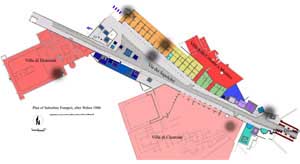 Plan of the Via dei Sepolchri, Villa delle Colonne a mosaico and surrounding suburban villas
Plan of the Via dei Sepolchri, Villa delle Colonne a mosaico and surrounding suburban villas
|
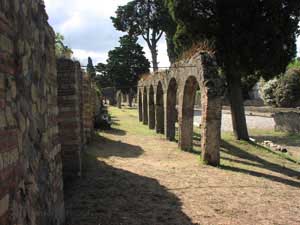
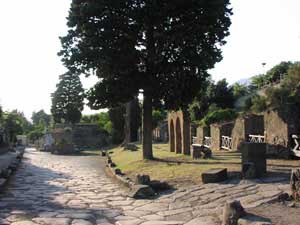 Shops and remains of the covered portico north of the Villa
Shops and remains of the covered portico north of the Villa
|
A number of features immediately suggest that this area is of great significance to an understanding of the via Consolare/via dei Sepolcri axis that coordinates the Project's goals. As has already been noted above,the general area of the Villa delle Colonne a mosaico contains a variety of building types in the final phase including a row of fourteen shops with retrobotteghe and a arcaded frontage running along the approximately 180m from where the road begins to widen into a large triangular expanse until it forks into two separate ways; one continuing in a roughly north-west direction, presumably eventually to Herculaneum, and the other, the so-called via Superior whose course can be traced at least as far as the Villa dei Misteri where it passes into a covered front entrance and seems to continue further to the north. The underlying topography of the area slopes dramatically from the west to the east and from the south to the north so that a change of more than 4m in elevation is visible from the lower parts of the Villa delle Colonne a mosaico to the upper floors and terrace, much of which lies outside the excavated area of the site. Indeed, the change of elevation is so significant that at the top of the hill, parts of the the Villa were seemingly buried under less than a metre of volcanic materials during the eruption. The Villa made use of this high underlying ground to build a dramatic portico and vista point which even today presents a commanding view of the via dei Sepolcri, the Porta Ercolano and the entire Bay of Naples, especially southward towards Sorrento and the Monti Lattari. Nestled partially within the hillside, the row of 14 shops makes use of the natural topography and also structurally supported the upper stories of the Villa. In fact, the two are so integrated that parallels could be drawn between this arrangement and the appearance of the caseggiati of Ostia in which the lower shops were occasionally located under relatively luxurious living accommodations that had many features in common with this villa, but were located deep in the urban environment. The villa, situated atop its pedestal of shops and pergulae, was the most visible and remarkable monument one would witness as one approached the city from the north. Such attention to presentation is echoed in the work lavished upon the rebuilt Porta Ercolano such that it appeared to be a triple triumphal arch that was quite possibly even adorned with statuary, indicating the importance that the road had for the city. |
The areas of the Villa delle Colonne a mosaico therefore present an extremely interesting area of study that is strongly integrated to the Project's research questions. The numerous tomb structures for which the street is named were intensely studied and dated (where possible) using epigraphic information (Kockel 1983). Interestingly, the majority of these structures have been dated to the final period of the city, and certainly none seem to date prior to the foundation of the Roman colony in 89 BC. However, the discovery of numerous 'Oscan or Samnite' burials in the area suggests an earlier period of funerary ritual use of the region that had clearly gone out of use by the time of the building of the Villa. The degree to which residence and funerary rites were mutually compatible within a single area is an interesting question which has yet to be examined fully. The environs also contain the remains of a number of other villae suburbanae: the Villa di Diomede, the Villa di Cicerone (reburied) and of course the Villa dei Misteri. This gives a strong testimony to the wealth of the area and the desire of at least some of the wealthiest Pompeians to live just outside of the city where there was more room for the construction of near-palatial estates. Ironically, the least visible and least noticed of these today was probably the most ostentatious in the final phase of the city. The decoration in fine painting and mosaics, the grandeur of the architecture and the size of the servant quarters put the Villa delle Colonne a mosaico on a par with or greater than its immediate neighbours, above which it literally towered. Finally, the row of shops that lie beneath the Villa, which was certainly built during a combined sequence of construction, implies that one source of the villa owner’s wealth was the trades practiced by those who worked and lived in this complex. Therefore, the shops supported the Villa economically as well as physically, extending the metaphor into a clearly visible statement of the social hierarchy of the city – a statement that complemented the public display that the Villa itself represented.
|
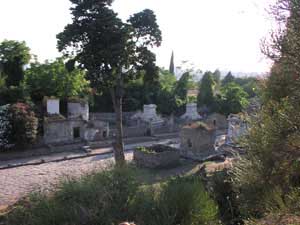
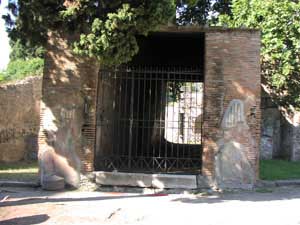 Via dei Sepolchri (top) and the main entrance to the Villa delle colonne a mosaico (bottom)
Via dei Sepolchri (top) and the main entrance to the Villa delle colonne a mosaico (bottom)
|
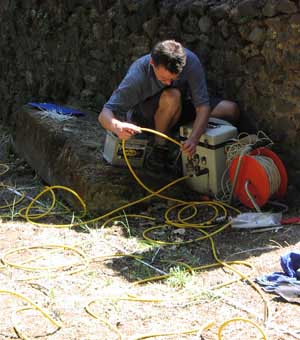 Resistivity testing in the Villa delle Colonne a mosaico
Resistivity testing in the Villa delle Colonne a mosaico
|
Resistivity in 2005 In 2005 a resistivity study of the area was conducted utilizing a Geoscan RM-15 and Geoscan FM-18 & 36 to examine three 20x20m ‘grids’ within the block. This resistivity meter measures the level of resistance between a minor electric current sent between two probes 0.5 meters apart at each point of contact with the ground surface. The instrument logs a specific reading at .25, .5 or 1m intervals within a particular transect, presenting a ‘plan view’ of results based on the systematic traverse of parallel 1m wide, interval, transects across a given grid. Resistivity measurements were conducted in three major zones of the area of the Villa delle Colonne a mosaico. Area A was located in the northwest corner of the viridarium of the Villa delle Colonne a mosaico, area B comprised the raised platform with columns which formed the main entrance to the Villa interior from the large space with a sacellum, and area C encompassed most of the porticus in front of the shops along the via dei Sepolcri. (cf. Figure. 4.4). It was noticed at the time that the readings were carried out that dry soils seemed to be impeding the quality of the readings taken. Unfortunately it proved impossible to overcome these difficulties in the first year and therefore, the results of this first phase of examination, due in part to the arid physical condition of the soils and also to the nature of the examinations undertaken, were inconclusive, largely producing null readings. The decision was made to return in the following year and to apply a different type of examination. |
|
Resistivity in 2006
In 2006, Electrical Resistivity Tomography was utilized through the generous availability of Gianfranco Morelli and Federico Fischanger of Geoastier S.r.l., and produced resounding results. The research made use of an IRIS Syscal Pro Resistivity Meter which has 72 separate electrodes spaced at even intervals down a long cable. Measurements made along this cable are received on 10 channels and allow for the line of the cable to be measured in many thousands of combinations in only a few minutes. This procedure, which is called a ‘pseudo-section’ presents a type of analysis and results which differ from those produced via standard resistivity. Rather than producing a plan of the subsurface stratigraphy, the results take the form of a ‘section view’ through the deposits under its array, as if the soils had been sliced through and offering the opportunity to measure the approximate depth of the anomalies it encounters, in this instance up to 2.5m below the surface. In addition to long sections, the IRIS Syscal Pro can be set up as a grid with the long cable running back and forth across the area. This produces a number of closely spaced transect sections which can be interpolated to produce a plan view of the subsurface features. However, more than a simple two dimensional picture from above, this plan view, like the sections mentioned above, also contains information on the subsurface stratigraphy at depth. A total of nine 12m long transects were conducted in three separate zones of the area of the Villa delle Colonne a mosaico. One set of four transects were conducted in the long stretch of grass-covered soils in front of the western shops that line the via dei Sepolcri. The area measures approximately 8-10m wide between shop front and road. The transects were aligned in a manner that recorded both the front room of the shop, the arcade front, and downward sloping area between the colonnade and stone paved street. The second venue included two areas inside the house: the open ‘courtyard’ of the colonnade and the viridarium of the mosaic columns. Within this area three 12m transects were conducted. Two were aligned parallel to each other and perpendicular/tangential to the third. The final area was located in a trapezoidal space defined by high walls directly behind the prominent tombs aligned on the avenue to the south of the Villa proper. Today this space is characterised by several large trees and large amounts of rubble debris. |
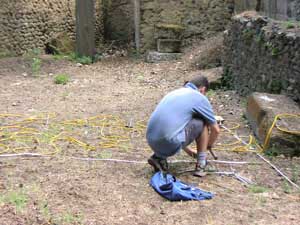
 Resistivity testing in the Villa delle Colonne a mosaico
Resistivity testing in the Villa delle Colonne a mosaico
|
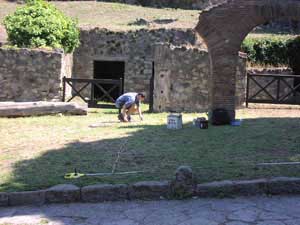 Resistivity testing in front of the row of shops along the via dei Sepolchri
Resistivity testing in front of the row of shops along the via dei Sepolchri
|
Preliminary Interpretations
While a complete understanding of this important area at the northern end of the Via Consolare must await further examination and potentially targeted stratigraphic excavation, a number of preliminary conclusions may be suggested at this stage. Geophysical results indicated the existence of subsurface anomalies characteristic of resistive features such as walls or voids. The alignments of these features imply varied inhabitation and mixed utilization of the area of the Villa delle Colonne a mosaico for a much longer period than has previously been considered. Whilst supporting Kockel's conclusion that the roughly square shaped central core of the villa is likely to be the earliest among the currently standing walls, there are traces suggestive of more features built along a similar alignment. Similarly, features can be found running parallel to the edge of the Via Sepolchri/Via Consolare, undermining any suggestion that the course of this road changed dramatically during the history of the site. Finally, the geophysics provide evidence for stratified depsosits in the area despite heavy bombing in 1943 and previous excavations. This means that future work in the Villa will allow for a complete sequencing and understanding of this important area outside the city walls of Pompeii. |
|
Website Content © Copyright Via Consolare Project 2018
| ||||||||